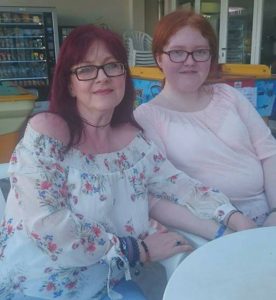Name: Carol Cochrane
Role: Support Specialist and Volunteer Manager for Scotland
Tell us a bit about your role and the type of things that you do day-to-day.
I support people at any stage in their brain tumour journey. This can be by providing brainstrust resources, through coaching, answering any questions they have and generally being a pair of ears removed from their situation but, having been there myself, that understands.
What are your favourite things about your role?
Most definitely the people I meet through my work. It’s a hugely humbling job and there is a great deal of trust that you build up with the people that you’re working with. The feedback from people is always lovely knowing the impact we make as a team.
I’m also lucky I get to attend conferences so I get the opportunity to see any progress made on the medical side of things.
Our work evolves all the time and with changes we’re constantly learning. No two days are the same.
What are the biggest challenges of your role?
You want to be able to reach everyone who needs support and you want everyone to have access to our information. Thankfully I’ve built relationships with other cancer charities who are happy to stock some of our resources and signpost people to us.
Some of us work from home which could be a challenge but we speak and meet regularly so we’re always there to support one another.
What are your hopes and plans for your community?
To have a community where people feel supported and resourced with the opportunity to meet others through our meet ups and well-being workshops. The social aspect is so important as it can be very isolating. Meeting with others in a friendly, informal setting is priceless.
What led you to apply for the role of support specialist at brainstrust?
In a nutshell – the support my family received from brainstrust!!
My super healthy dad was diagnosed with a glioblastoma in July 2012. Sadly there was nothing that could be done to treat him and we were sent home and told he would be dead within six months. My dad didn’t want to know anything about the tumour, my mum struggled to cope so I felt I had to try to regain some control of the situation to ensure dad’s wishes were met. My dad’s only wish was to die at home and I was willing to move mountains to ensure this would happen.
The feelings following the diagnosis were awful – people were so lovely to us but no one really understood the impact, fear and isolation we were feeling. I applied for a brain box and it was a defining moment for us. From then on brainstrust ensured we were never alone.
We fulfilled dad’s wish to die at home and the last six months we spent making memories with dad, ensuring nothing was left unsaid and his final journey was wrapped in warmth and love.
Losing dad was the hardest thing I’ve ever had to face but brainstrust supported us every step of the way and ensured we were able to care for dad at home whilst making precious memories.
I loved the whole ethos of brainstrust and felt no one came close to offering what they did. The loss of my dad left a huge gap in my life but a passion to want to help families just like ours. The opportunity for regional support came up in my region and I felt I had something to offer.
What is something you’re particularly proud of?
As a family we regularly fundraise in memory of my Dad. A few years ago I was looking for something that I thought would challenge me as it might be a way of getting more donations! I hate heights ( you can’t even get me up in loft in our house!) and for some reason I thought a sky dive seemed a good idea.

Within a fortnight I had exceeded my fundraising target so there was really no going back. Some of my friends from the brain tumour community had donated for me to wear grey pins with their loved ones names on it on my sky diving suit.
The day itself was a beautiful clear day and it was nerve racking as the plane climbed to 10,000 feet. The drop itself was over quickly but nowhere near as bad as I had anticipated. My tandem instructor, Chris, even persuaded me to open my eyes to point out some landmarks on the way down.
It was a once in a lifetime experience and only my Dad and raising money for brainstrust would have got me to do it, but I like to think Dad would be proud. It’s still not cured my fear of heights mind you!!
If you live in Scotland and would like to get in touch with Carol, please email carol@brainstrust.org.uk





